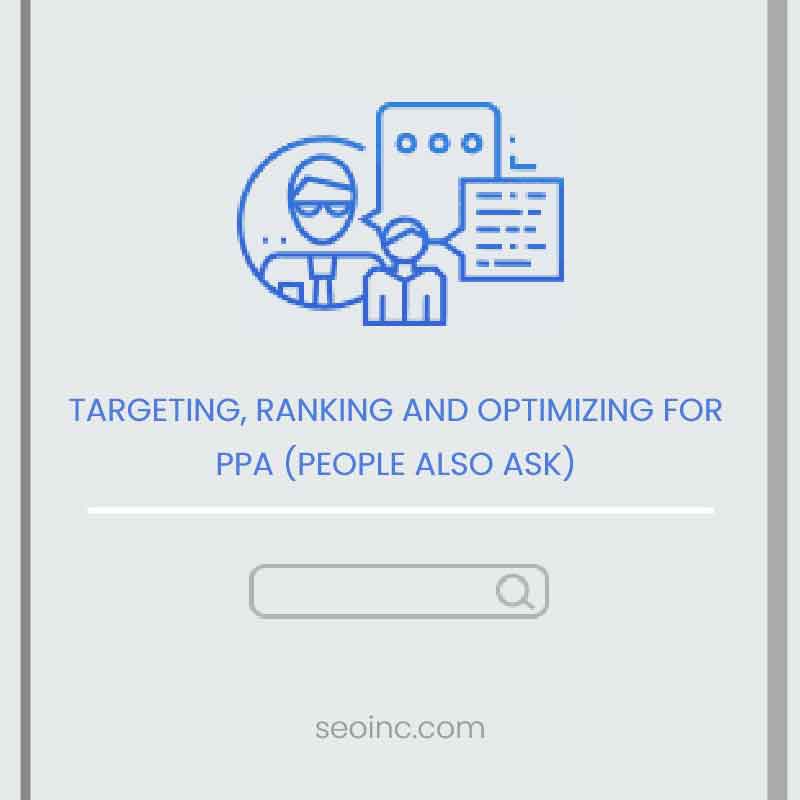[ad_1]
People Also Search For (PASF) is an SEO Strategy for 2022 and beyond. As Google continues to add variety and make the search engine results pages (SERP) increasingly dynamic, business owners and search engine optimization (SEO) professionals alike can quickly become overwhelmed. It may not seem like it at first glance; these changes present several advantages. Now it’s time to focus on People Also Search For and use that as a strategy for targeting new traffic on what people are also asking.
With all of the SERP variety, there are new ways to gain more exposure and search, so the ultimate goal of SEO is no longer to rank number one. The fact of the matter is that because of these dynamic search features like Featured Snippets and People Also Ask, the returns on top organic rankings are diminishing.
Google continues to add more elements to the SERPS and includes as many paid ads into the SERPs; that number one ranking isn’t what it used to be. As such, SEOs and business owners have to adjust and adapt. One way to do this is to aim for the PAA box on as many keywords as possible.
People Also Search For, what does it mean?
People Also Search for or PASF is a feature that is only shown to users who click on a search engine result and come back to the results page immediately. Google assumes that because the user immediately comes back to the SERP as they didn’t find what they were looking for, so Google offers other suggestions to help them get the results they wanted in the initial search. The suggestions are related queries and part of what is called User Intent. Finding out the intent of the user and providing options to find the exact intent of the search.
Google’s People Also Ask (PAA)? Or People Also Search For Examples.
People Also Ask boxes are a dynamic feature from Google that contains questions related to the original search query.
In terms of SEO, this is a goldmine of data since it comes directly from Google. Every search result on the SERP is associated with at least six PASF keywords. You can use these to expand your potential reach in Google in multiple ways.
Featured Snippets Don’t Seem To Be Affected
When replicating the click-through and back button tests to get the PASF boxes to display, we noticed the featured snippets did not show the PSAF boxes. The featured snippets did not change. This tells us it’s even more critical to be aiming to rank in Google Position Zero.
Suppose your analytics data shows that many people are bouncing off your pages for specific keywords or queries. In that case, it is a good indication that you are not providing the value or the answers the users need. Pay close attention to the list of related questions on the SERPs, and make sure your content addresses those, too. This strategy should make the page more beneficial to your audience.
If you’re confused about the best way to format and add content or how to create content that is more useful to users, take a look at what sites rank higher than yours – or content from your direct competitors. How does it differ from yours in terms of style, length, topics covered, and language used?
Take notes on what you see in each of the competition’s content – and look for patterns. The aim here isn’t to copy what the competition is doing but to make your content better. Do this by focusing on the user first – the search engine second.
Create Content Around the Related Queries
Another approach is to start expanding the information on your website. Think about topics related to your primary topic, and go to town, creating more valuable content. Having this information available will only make it possible for you to grow your business faster and more authoritative at becoming an expert in your business verticle.
Imagine potential customers finding you in organic search results but don’t find what they’re looking for. Instead, they may be frustrated, click back to the SERP, and navigate to a related query. Boom. There you are again. That’s powerful marketing.
Look familiar?
Once a user clicks one of the questions, the box expands to show text if it was a brief answer to the question along with the source URL where the text was extracted. There is also a shortcut link for performing another Google search for this particular question.

People Also Ask box initially contains four questions. But as people continue to click on a PAA question, two or three more items are added to the box. PAA boxes are, therefore, ever-expanding, with new questions infinitely being added to the box.
The number of PAA doesn’t relate to keyword patterns or verticals right now, but this may change later. We may see comparative keywords more or less inclined to a fixed number of PAA results. The number of questions you can use to find SEO opportunities will vary.
What You Need to Know About PAA
PAA SERP Positions Change
It’s natural to assume that PAA boxes appear in the same location on a SERP if and when Google triggers them most of the time.
However, PAA is distinct from featured snippets – those always appear at the top of the SERP. PAA can also be found in various parts of the page.

It’s essential to understand the implications of the different positions of PAA in the SERPs because they impact organic results’ click-through rate, especially on mobile, where space is limited.
PAA Can Trigger Video Results
Given that many queries are based on “What is?” “How to…” and “Why is/are?” it makes sense that video results would be included.
It’s reasonable to believe Google will continue to test this to a point where most of the keywords that show video results in the SERPs will also trigger videos in the PAA listings.
This means you should take time to optimize your YouTube and video results so that you have a higher chance of appearing in the PAAs.
PAA Frequently Repeat and Trigger Featured Snippets
Most PAA questions trigger featured snippets. The same PAA question and answer can display for different keywords. The dame answers and listings that appear for a particular inquiry in the PAA can also appear for other questions triggered by PAAs.
People Also Search For Vs. People Also Ask
There’s absolutely no reason you should choose one over the other. Expanding your content to create more value for your customers while also aiming to display in the SERPs for both these features is optimal. The more organic opportunities you have, the more you’ll be presented to your audience, which is good for trust, credibility, and traffic.
[faq-page]
[qa-schema question=”What is People Also Search For?” answer=”People Also Search for or PASF is a feature that is only shown to users who click on a search engine result and come back to the results page immediately. Google assumes that because the user immediately comes back to the SERP they didn’t find what they were looking for, so they offer other suggestions to help them get the results they wanted in the initial search. The suggestions are related queries and part of this is called User Intent. Finding out the intent of the user and providing options to find the exact intent of the search.”]
[/faq-page]
[ad_2]
Source link


